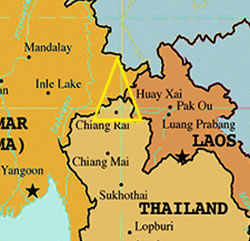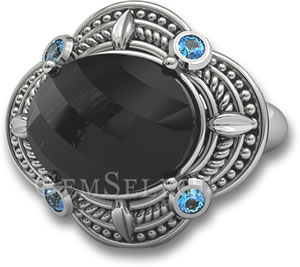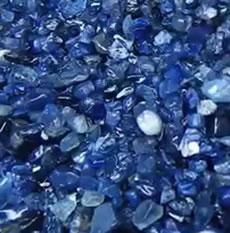Sapphire Gems from the Golden Triangle
 |
| The Golden Triangle Where Laos, Thailand and Myanmar Meet |
The blue sapphires from Sri Lanka (Ceylon), Kashmir and Pailin in Cambodia have been long admired for their exceptional color and quality. However, there is another sapphire producing region, not far from our home in Chanthaburi, Thailand. The lesser-known mining location is perhaps more famous for its long history of opium production, but since more recent times, the gems and silver jewelry coming from this area have sparked a renewed interest in the region known as the Golden Triangle of Southeast Asia. Located in the heart of the Golden Triangle lies Huay Xai, the capital of Bokeo Province in Laos. The name "Bokeo" is a term that translates as "gem mine" in Laotian language. The remote mining area of Huay Xai in Laos is located adjacent to Thailand's side of the great Mekong River, and just a short distance from the border point of Burma (Myanmar) as well. For many generations, the area which makes up the Golden Triangle has served as a resting point for travelers going between China and Thailand, and it has become one of the most popular tourist destinations of Southeast Asia, where visitors can admire the beauty and vastness of the great Mekong River, as well as taking in the sights of three different countries meeting at a single point.
The blue sapphires produced in the Golden Triangle are mostly mined near Huay Xai. Though technically the sapphires mined here are often traded as Thai sapphire, they are actually Laotian sapphires. Unfortunately, the material mined from Huay Xai yielded rather small gems, most of which were less than a carat in weight. Even though the quality of sapphire from Huay Xai is excellent, for Laos to establish itself as a more well-known and leading source for sapphire production, they'll need to start discovering larger facetable material. Very few gems mined from this region will yield a cut gemstone in the 1 to 2 carat range. There have been a handful of blue sapphires mined from Huay Xai weighing over 2 carats, but so far, it is an extremely rare occurrence. Even though the sapphires of Bokeo may be on the smaller side, they make up for lack of weight with their phenomenal color, which tends to range from a rich medium-blue to an attractive deep-blue color, not inky dark-blue like many of the sapphires mined from within Thailand and Australia. In the mining province of Bokeo, there are other color varieties of sapphire available too, including black star sapphire, yellow golden sapphire and fine green sapphire. In addition to gem-quality varieties of corundum, the Golden Triangle region is known to produce fine quality spinel and zircon, although for Huay Xai, the focus is primarily on the production of blue sapphire.
 |
| Black Spinel Thai Silver Ring |
Although it is relatively unheard of by most gem and jewelry buyers, the gem mining for Golden Triangle sapphire is nothing new. In fact, records indicate that sapphire gems have been mined in this region for hundreds of years since the late 19th century, particularly by the people of the Shan tribe, one of the many local indigenous hill tribes of Myanmar (Burma) and Thailand. About a century after the discovery of black spinel; gem mining and jewelry production started to become heavily commercialized and it didn't take long for the Golden Triangle to establish itself with a fine reputation for high quality gemstones and skillfully made gemstone jewelry, mostly composed of Northern Thai silver and handcrafted by local artisans. The skillful silversmithing and craftsmanship by the local Golden Triangle tradesmen is beyond exceptional. In fact, many claim that the silver gemstone jewelry produced here is among the finest in the world.
As production and trading of black spinel mined from the Golden Triangle began to grow, the commercial trading of gem-quality corundum (ruby and sapphire) from this region also began to spark an interest in the international market in the late 20th century. After the initial sapphire mines of Bokeo were discovered, sapphire, garnet and various varieties of quartz gemstones were also found in the neighboring area of Chiang Khong, a Thai district of Chiang Rai province. Chiang Rai Province is situated directly across the Mekong River on the Thai side of the Golden Triangle bordering Laos and Myanmar (Burma). For many years, red garnet mined from Chiang Khong was mistakenly thought to be ruby. As a result, Siam appointed Mr. Herbert Warrington Smyth, a British mining engineer, to survey the area and report his gemological findings to the Siam Department of Mines. The officials of Siam were so full of hope and extremely eager to announce the discovery of fine Thai ruby, that they had already started to make plans in anticipation of discovering a large yield of beautiful red rubies. Unfortunately, after completing the survey, Mr. Smyth reported a lack of ruby in the area, but instead, what was thought to be ruby for many years, had been identified as a type of red garnet. Needless to say, the identification of red garnet rather than ruby was quite a disappointment for the Thai government. What made things worse, was that prior to the discovery of 'red garnet', one Thai official exhibited a bit of over-confidence, or as they say, 'counted his chickens before they hatched'. Prior to the survey results being made public, the Thailand official representative for Siam had purchased a Burmese ruby earlier and presented it to Bangkok with a report stating that it was mined from Chiang Khong, Thailand, which was later proven to be untrue.
 |
| Blue Sapphire Rough |
While the presence and mining of sapphire originating from the Golden Triangle region has been worked and known for hundreds of years, sapphire was not commercially exploited until the late 20th century. Unfortunately, after the initial launch of commercial mining, it came to an abrupt halt and was ultimately short-lived due to legal issues and charges brought up against the main shareholders and the General Manager of the mining company which owned the rights to the Bokeo mines; Gem Mining Lao PDR Company Limited. The Lao government proceeded to nationalize the mines and arrested those associated with corruption charges. Today, the mining of gemstones in the Bokeo region of the People's Democratic Republic of Lao is primarily operated by Sino Resources Mining Corporation, a Taiwanese entity with controlling interest in the gem mine joint venture. Today, Bokeo mines are producing a variety of gems including spinel, zircon and various colors of sapphire.
Before the industrialization of mining, locals from Bokeo would mine their own gems and then find their way to Chanthaburi, Thailand, which is known as the center for international colored gemstone processing and trading. The gem miners from Bokeo would supply many of the local Chanthaburi shops and resellers with fine quality Laotian gems to be cut and processed. The rough gems were turned into stunning polished pieces and offered for sale in the famous outdoor gemstone market of Chanthaburi; a model example of gems 'from mine to market'. It is in the famous "Gems Street" of the small town of Chanthaburi where most colored stones will meet their first buyers, and from here, they are traded, bought and sold on to the rest of the world by visitors.
Many say that Laos is similar to Thailand fifty years ago, and the Golden Triangle area has much to offer apart from an illustrious history of opium production. Visitors to Bokeo can take a mountain trek, catch a glimpse or hear the song of a black-cheeked gibbon, take a trip on the mighty Mekong River and enjoy slow village life. There are even tours of sapphire mines for gemstone enthusiasts. Although the blue sapphires mined there are on the small side, they are perfectly blue, and as they say, it's not the size that matters. It's what you do with the gems that counts.
|